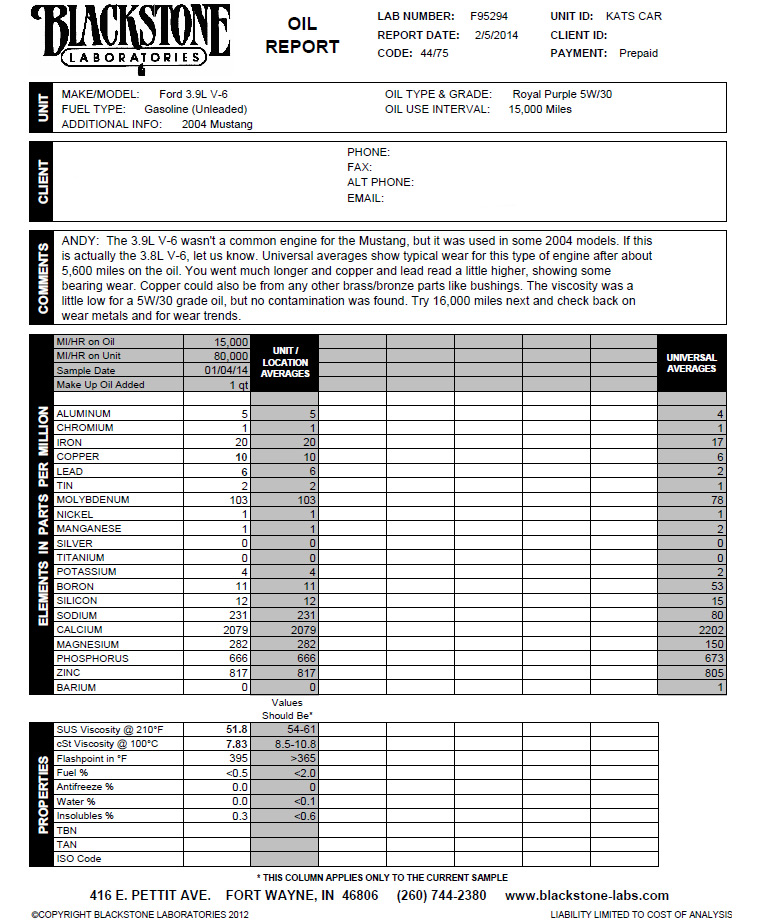Why You Need an Oil Analysis

Oil changes are like finger prints: everyone has them, and they’re all different. Ask people how often you should change your oil, and you’ll get everything from the retiree in his Corvette proudly saying he changes out synthetic at 2,000 miles, to the Camry owner giving you a blank look and saying “You have to do that?”
While it’s a generally accepted given that you have to change your oil, the big question is: how often? If you drive too hard and too far between oil changes, it can degrade and damage your engine. If you change it too early, you are wasting money, time, and resources. So how do you know when it is time to change the oil?
A big hint can be learned from sending your oil out to a laboratory for analysis. Several labs around the country can take a look at your used oil and compare it to new. The difference in cleanliness, thickness, and other factors are a telling sign of the present condition of your engine, and if you should go longer/shorter periods between oil changes.
I send my oil out for an analysis about every other oil change in order to have peace of mind that my extended oil changes are not damaging anything. So far, I’ve been right. I send out to Blackstone Labs, but you may prefer another lab.
Collect and mail
Once you have found a lab you want to send your oil to, be sure to read up on oil sample requirements, and costs. For example, every lab will tell you the sample needs to be in a leak-proof container, but the sample size varies by the lab. Be sure to give them enough, or they won’t be able to test it. Include payment for the cost of the lab work, which averages about $25. The lab can examine all kinds of oil, even from transmissions and differentials, so make sure you are selecting the right tests.
Decide what optional tests you want to pay for. A $10 TBN tests measure the amount of active additive left in your oil. This is useful to know, as this informs you of the oil’s ability to go more miles without causing wear. Other people might not care, so they can save some cash here.
Once you have the oil properly packaged, hit the post office. When they ask if anything is “perishable, hazardous, fragile, etc” just say no. Oil is an approved substance for mailing by the USPS, so there’s no reason to stress here. Lab work and shipping might run a total of $40, but the results could save you a whole lot more than that.
At the lab
Once the oil sample leaves, you don’t need to do anything until you get your results. It will take about a week to get there, and you should get your analysis back within another week or so, usually by email. It takes a bit, as they are being thorough and running it through several tests, such as:
Spectral exam:
A spectral exam vaporizes the oil, then looks at the wavelengths of what remains. It’s far above my nerd science level, but I get that it can tell exactly how much of each element is in your oil sample. It’s an exact look at the metals and additives, which means it’s a great test for looking at engine wear. This is the test that will let you know if there is too much copper or nickel in your oil, and how you can help prevent wear to that specific part.
Insoluble test:
The insoluble test looks at the amount of abrasive solids that are present in the oil. Solids form from oil oxidation (when the oil breaks down due to the presence of oxygen and heat) and blow-by past the rings. This test tells you how good a job the oil filter is doing, and to what extent the oil has oxidized.
Viscosity test:
Viscosity is the thickness, or grade, of the oil. You know this as 10w40, 0w30, and so on. The lab can check to make sure the oil is still within the viscosity range that it was when you first opened the bottle. If your viscosity has changed, there’s a reason. The oil likely was overheated or contaminated with fuel, water, or coolant.
Flash Point test:
Just as it sounds, the flash point test measures the temperature at which vapors from the oil ignite. Since the lab knows at what temperature your oil should flash at, flashing at a lower temperature means it is contaminated, probably with gas. If the oil flashes at the normal temperature, you’re good to go.
Results
Once the oil analysis is completed, you will receive the results, which will look something like this:
Some labs only deliver analysis results, which can be confusing if it’s your first time or you’re not a chemist. I like Blackstone as they have someone to look over your results and type up a summary of what is going on in your engine. Handy.
Based on their analysis and summary, we were informed that the engine was aging well, and the extended oil changes were not hurting it. However, being a Reagan administration era design, the old Essex V6 was already showing some bearing wear at 80,000 miles. This isn’t really a factor for us, as we sold the car last year. We left the oil report with the rest of the service documents.
The occasional expense and waiting time of an oil analysis is easily outweighed by the valuable information gained. Whether it’s your baby that you’re going to keep forever, or a used car you just bought for a suspiciously low price, stay informed on what is going on in the engine with an oil analysis.





















































